Using a virtual machine is still our favorite way to run Windows on a Mac and here we’ve tried and tested a range of them to see which is the best one for 2026.
Nowadays, there are many ways to use Windows software or games on a Mac, and although virtual environments are still probably the most popular, other methods are available, many of which are free.
In fact, some methods don’t even require installing Windows at all as they use compatibility layers to “translate” Windows software to work in macOS or access Windows remotely.
So whether you want to run Windows, Linux or even an older version of macOS on your Mac, we’ve tested and reviewed a range of free and paid options to see what they offer and how they perform.
| Tool | Best For | Pricing |
|---|---|---|
| Parallels Desktop | Fastest and easiest way to run Windows on a Mac; best Apple Silicon performance | $99/year (Standard), $119/year (Pro) |
| VMware Fusion | Free virtual machine; supports Intel & Apple Silicon Macs | Free for personal use, paid Pro varies |
| UTM | Free hobbyist VM for ARM/x86 emulation; flexible but manual | Free |
| CrossOver | Runs many Windows apps and games without needing Windows; very gaming-friendly | $74 (1-year), subscription options |
| Whisky | Lightweight, open-source wrapper for Wine; great for running Windows apps on Apple Silicon Macs | Free |
| Windows 365 | Cloud-based Windows PC accessible anywhere; mainly aimed at Enterprise use | $32–$162 per user/month |
| Wine | Compatibility layer for running Windows apps; no full Windows install required | Free |
| VirtualBox | Free virtualization on Intel Macs (no Apple Silicon support) | Free |
Table of Contents
1. Parallels
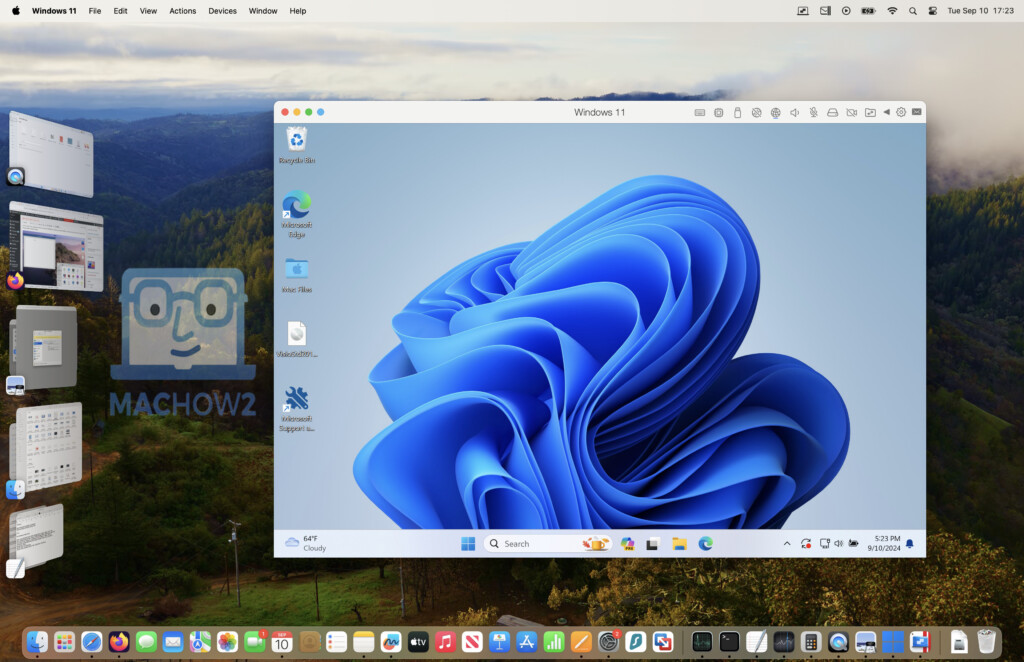
Parallels has long been our favorite virtual machine thanks to the way it automatically installs Windows on a Mac and makes switching between macOS and Windows so easy.
Parallels was also was the first VM to be updated so that it can run Windows on Apple Silicon Macs.
In fact, Parallels has now been endorsed by Microsoft making it on the only virtual machine for running Windows on a Mac officially recommended by the company.
In just a few clicks, Parallels automatically downloads and installs Windows 11 on Intel Macs and Windows On ARM on Apple Silicon Macs.
Windows ARM is a slightly different to the Intel version of Windows most of us are familiar with, but it’s the only version of Windows that will work with M-series chips (i.e. M1, M2, M3, M4 and M5 Macs).
Although not all programs and applications are available for Windows ARM, most will run in it thanks to what’s known as x86 emulation which translates all Intel Windows software to work on Windows ARM.
At the moment, you can’t actually purchase individual licenses for Windows ARM but Microsoft currently allow it to be used for free by individuals – only businesses must purchase it through special volume licensing channels.
Parallels Desktop does now includes experimental support for running x86 and x86-64 versions of Windows on Apple Silicon Macs using an emulation layer but this feature is still extremely limited.
It’s very slow, there’s no USB passthrough, proper audio support or advanced graphics acceleration so we recommend sticking with Windows ARM.
Once installed, Parallels allows you to switch between macOS and Windows instantly whenever you want.
Parallels also offers the best integration between macOS and Windows of any VM we’ve tried, especially in Coherence mode which effectively blends your Windows app into macOS if you want to.
Dragging and dropping files between the two operating systems is also really easy as is connecting peripherals such as printers, external drives and even game controllers.
There’s also a handy “rollback” mode which allows you to rollback to a more stable version of the virtual environment if anything goes wrong.
Parallels 26 was recently released to fully support macOS Tahoe, Windows 11 25H2 and offers better tools for managing storage space and IT admins.
For more on what Parallels can do, you can also check out our full Parallels review or watch us install it below.
Pricing: Free Trial / Prices normally starting from $99.99 (£89.99) or $219.99 (£154.99) one time purchase. Currently 35% off.
Pros:
- Very easy to install Windows
- Officially authorized by Microsoft to run Windows 11 on Mac
- Runs Windows and macOS simultaneously
- Excellent for gaming
- Fast startup and shutdown time
- Supports Windows keyboard shortcuts
- Optimized for macOS Tahoe and Windows 11 25H2
- Now supports DirectX 11 and Metal
- Officially supports running Windows on M-chip Macs
- Can be deployed across lots of Macs by IT teams
Cons:
- Updates aren’t free
- Requires a separate license for each Mac you want to install it on
- Subscription pricing model
- Can’t accelerate graphics card for gaming as well as Boot Camp
- Will not support games that use anti-cheat protection software
- Does not support running DirectX 12 (but does support DirectX 11)
2. VMware Fusion Pro (Free)

Without doubt the next best thing after Parallels is VMware Fusion Pro.
Although it has lagged behind Parallels for some years, VMware Fusion Pro now makes it extremely easy to install Windows on a Mac.
Even better, it does it all for free.
The latest version of VMware Fusion Pro now automatically downloads and installs Windows 11 for you, just like Parallels does.
Like Parallels, VMWare Fusion Pro only supports installing Windows ARM on Apple Silicon Macs which is the only version of Windows that works on M-series chips.
It has also improved integrating Windows and macOS meaning its now easy to drag and drop files between the two operating systems.
VMWare Fusion Pro has also now been fully updated to work on Apple Silicon M-Series Macs and macOS Sequoia although it was a long way behind Parallels in supporting the Apple Silicon chips.
The latest version also has improved Metal-accelerated DirectX 11 3D graphics support for better performance when playing Windows only games on a Mac as you can see below.
Like Parallels however, one downside is that VMWare Fusion Pro doesn’t support DirectX 12 or Windows games that use anti-cheat software to run.
The biggest plus of VMware Fusion Pro is that since November 2024, it’s free for personal, educational and even commercial use.
The downside of this is that there’s no official support – you’ll have to seek support from the VMware community if you have problems.
You can read more in our full VMware Fusion review for more.
You can also read our direct head-to-head comparison of Parallels vs VMware Fusion here.
Pricing: Free for personal, educational and commercial use
Pros:
- Free for all types of usage
- Supports Windows ARM on Apple Silicon Macs
- Supports Windows 11 on a Mac
- Supports Metal and improved 3D graphics rendering
- Suitable for Windows gaming and CAD software
- Pro version can be deployed across enterprises
Cons:
- Can’t accelerate graphics card for gaming as well as Boot Camp
- Integration between macOS and Windows not as close as Parallels
- Doesn’t support DirectX 12
- Doesn’t support games with anti-cheat software
- Support is community only
3. UTM (Free)

UTM is an impressive free VM that allows you to run Windows, Ubuntu and macOS.
UTM is based on the free QEMU open source system emulator but is easier to use thanks to the UTM User Interface which doesn’t require any knowledge of QEMU command arguments.
The free app supports running Windows and other operating system on both Intel and Apple Silicon Macs.
While Apple Silicon Macs can normally only run Windows ARM, UTM even enables them to use Intel “x86” versions of Windows on Apple Silicon although it does this using emulation which isn’t as smooth or stable as virtualization.
This includes running older versions of Windows 7, Windows XP, and other older operating systems such as really old classic versions of OS X.
It’s important to be aware that running Windows on M-chip Macs is more complicated and difficult to setup with UTM and there’s a lot of manual configuration required.
You can even attach external devices to UTM such as external displays although it does not support external hard drives or drag and dropping of files between macOS and Windows.
Overall though, despite a few little tricks needed during setup to get it running well, UTM really impressed us as a free way to run Windows on Macs.
You can check out our full UTM review here.
Pricing: Free
Pros:
- Free To Use
- Works on both Intel and Apple Silicon Macs
- Allows you to use Intel versions of Windows on Apple Silicon
- Supports connecting some external devices
Cons:
- Lacks basic features like drag and dropping of files
- No support for external hard drives
- Not as easy to setup and use as commercial products
- Requires some manual configuration on setup
- No customer support
- Doesn’t support 3D graphics acceleration for gaming
4. CrossOver
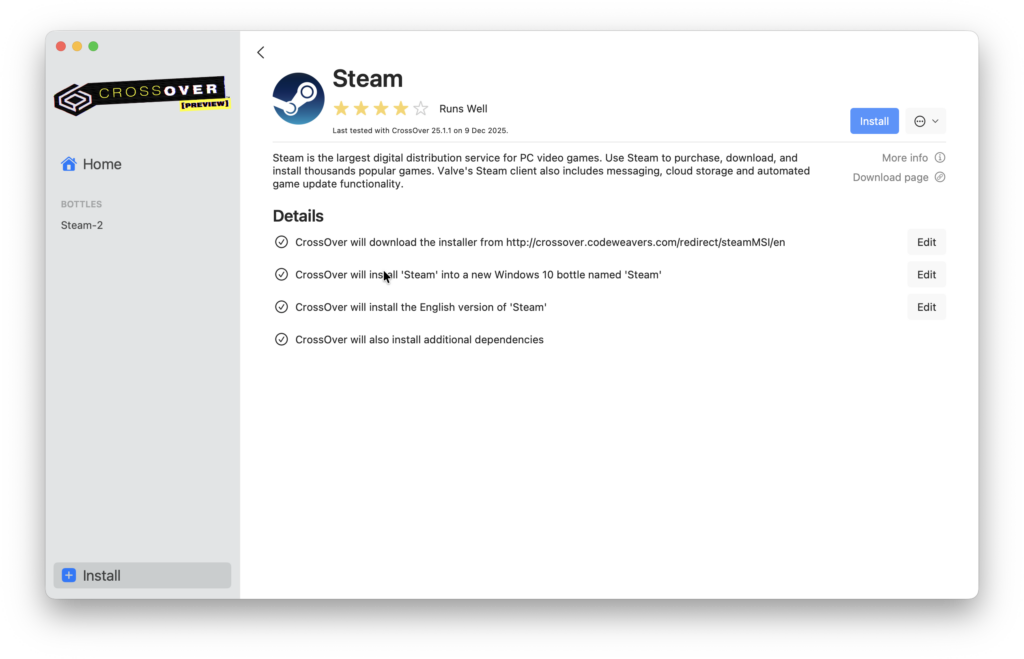
CrossOver is a powerful and incredibly easy-to-use way of running many Windows apps and games on a Mac without installing Windows or using a virtual machine.
It’s particularly easy and effective at running Windows only games on a Mac.
CrossOver is based on the Wine translation layer (see more about Wine below) but makes everything far simpler thanks to a more polished interface, automatic installers, and built-in support for Steam, Microsoft Office, and thousands of other Windows applications.
Unlike virtualization software such as Parallels or VMware, CrossOver doesn’t install a copy of Windows. Instead, it translates Windows API calls into something macOS understands, which makes it extremely lightweight and fast to set up.
Thanks to Apple’s Game Porting Toolkit technology, CrossOver now supports many DirectX 11 based applications and games. The Preview version even supports DirectX 12 which is one of the biggest advantages over virtual machines which can’t do this.
Performance varies depending on the game or app, but Steam titles such as GTA V, Skyrim, Fallout 4, and many others run surprisingly well.
CrossOver also supports custom “bottle” configurations to tweak if for those games that struggle to work with it.
There’s no need for a Windows license, no need to configure a virtual machine, and no complicated setup – most apps install in just a few clicks.
The main downside is that not all applications and games work, and some titles require extra tweaks. CrossOver maintains an online database showing which apps are rated Gold, Silver, or Bronze for compatibility.
Overall, CrossOver is one of the easiest and most efficient ways to run Windows software – especially games – on any modern Mac.
Check out our full review of Crossover for more.
You can also watch us playing the viral hit Where Winds Meet on a Mac using Crossover below.
Pricing: $74 (with a free 14-day trial) or $494/£414 for a lifetime license
Pros:
- No need for Windows or a virtual machine
- Excellent for running Steam games on a Mac
- Supports many DirectX 11 & 12 titles on Apple Silicon
- Lightweight and easy to set up
- Works on all Intel and Apple Silicon Macs
- Cheaper than Parallels + Windows license
Cons:
- Not all Windows apps and games work
- Some games require tweaks or community fixes
- No full Windows desktop environment
- Heavier or older apps may be unstable
- Less compatible than a full VM for business software
5. Whisky (Free)

Whisky is a lightweight and increasingly popular way to run Windows games and applications on Apple Silicon Macs using a user-friendly wrapper around the Game Porting Toolkit and Wine.
Unlike full virtual machines, Whisky doesn’t emulate Windows – it translates Windows API calls so apps can run at near-native speeds which is very similar to the way Crossover works.
This makes it especially appealing for gaming, where performance and compatibility can often beat more traditional VMs.
Whisky is still evolving and can require some trial and error, but it offers impressive results for many titles, particularly older or less demanding games.
It also integrates nicely with macOS, allowing you to create separate “bottles” for different apps and tweak settings on a per-title basis.
However, it’s not a replacement for a real Windows environment.
You don’t get full Windows features, system-level tools, or guaranteed software compatibility, and it’s unsuitable for professional Windows-only apps that rely on drivers, DLLs, or Microsoft services.
Overall, Whisky is a great option for Mac users who mainly want to play Windows games without installing a full VM. It’s fast, free, actively maintained, and designed with Apple Silicon performance in mind – but it’s not an all-round general-purpose Windows replacement.
Check out our guide on how to use Whisky on a Mac for more.
Pricing: Free
Pros:
- Free and open-source
- Excellent performance on Apple Silicon thanks to Game Porting Toolkit integration
- Great for Windows gaming without installing a full virtual machine
- Simple, lightweight interface with easy bottle management
- Runs many titles at higher frame rates than full VMs
- No license or Windows installation required
- Fast development pace and active community support
Cons:
- Not a full Windows environment – limited compatibility with professional software
- Still experimental and can require troubleshooting for certain games
- No guarantee of support for anti-cheat or multiplayer services
- Occasional bugs when updating Wine- or GPTK-related components
- Not suitable for apps requiring drivers, .NET frameworks, or deep Windows system access
6. Windows 365 via Windows App
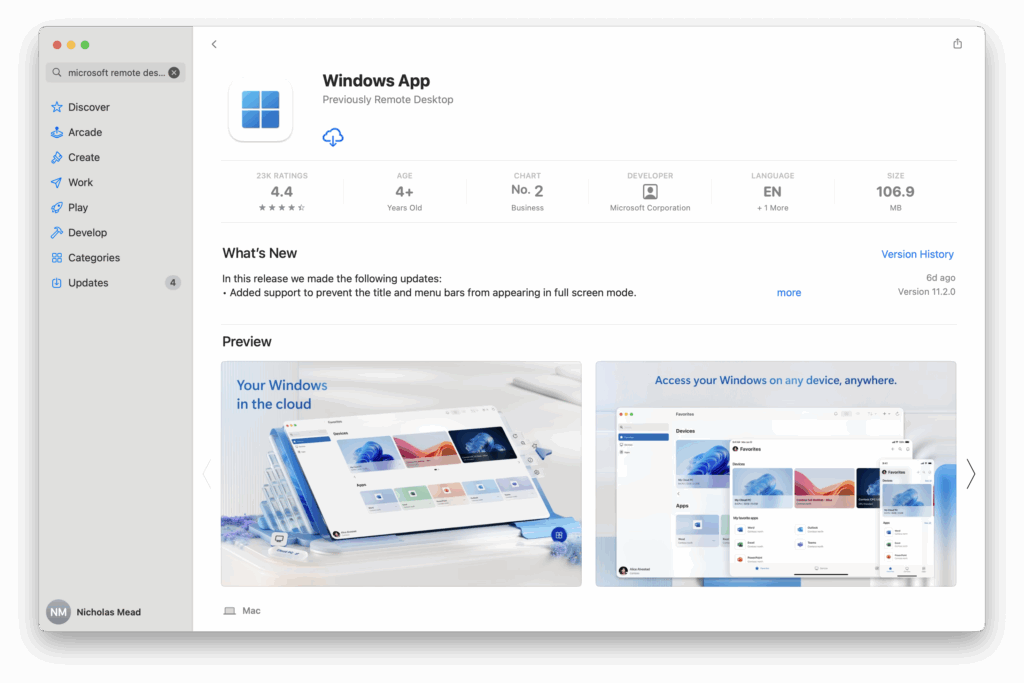
Windows 365 is Microsoft’s cloud-based version of Windows that lets you stream a full Windows desktop to your Mac through any browser.
Instead of running Windows locally, the operating system is hosted in Microsoft’s data centers and delivered on demand, similar to a cloud PC.
Because all the processing is done in the cloud, your Mac’s hardware doesn’t matter – even older Intel Macs and entry-level M-series models can run a high-spec Windows PC instantly.
The biggest advantage of Windows 365 is reliability and simplicity. Setup takes minutes by using Windows App (formerly Microsoft Remote Desktop) in the Mac App Store which connects you to a cloud version of Windows.
It’s also Microsoft’s most stable and officially supported way to use Windows on a Mac, especially since Boot Camp and Intel virtualization are no longer options on Apple Silicon.
However, Windows 365 is a subscription-only service and is aimed at businesses rather than home consumers. Pricing is higher than virtual machine software, and it requires a fast, stable internet connection.
It’s excellent for businesses, remote workers, and anyone who needs guaranteed access to a Windows PC from a Mac, but certainly not suitable for gaming or GPU-heavy workloads since the streamed desktop can’t match local performance.
Windows 365 is best suited to professional users who need full Windows compatibility without the complexity of setting up a virtual machine and who prefer a fully managed cloud environment.
Check out our full review of Windows App for more.
Pricing: Typical Business plans start at $32.00 per user for 4GB of RAM and 64GB storage
Pros:
- Full, official Windows environment streamed directly from Microsoft
- Works on any Mac, including Apple Silicon Macs without Boot Camp
- No need to install or configure Windows locally
- Highly stable and maintained by Microsoft with automatic updates
- Persistent cloud PC you can access from any device
- Excellent for business users needing enterprise-grade Windows access
- Strong security and compliance features built in
Cons:
- Subscription-only and more expensive than standalone VM software
- Requires a fast, stable internet connection for good performance
- Not ideal for gaming or GPU-intensive apps
- Not aimed at everyday consumers – business plans only
- Performance depends on network latency, not Mac hardware
- Limited offline functionality compared to local virtual machines
7. Wine (Free)
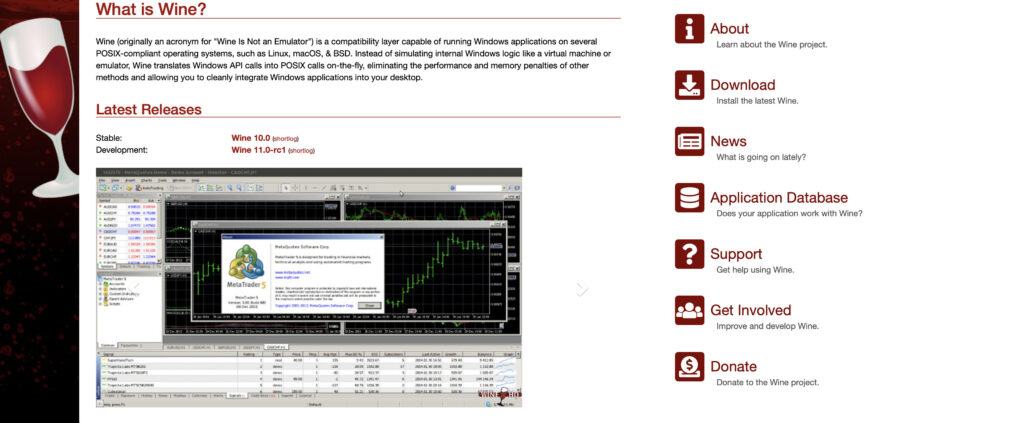
Wine is a free, open-source compatibility layer that allows you to run Windows applications on macOS without installing Windows. Wine is actually the basis of many apps like Crossover and Whisky but is a lot more complicated to setup and use.
Unlike a virtual machine, Wine translates Windows system calls into something that macOS can understand in real time, which makes it lightweight and fast.
Wine can run many Windows programs and older games directly on your Mac. It’s especially useful for developers, hobbyists, or anyone who wants to test Windows applications without setting up a full VM.
However, Wine doesn’t provide a full Windows desktop, and compatibility varies widely depending on the app. Some programs may require manual tweaks or additional configuration to work properly.
We’d strongly recommend using CrossOver or Whisky over Wine because on its own, it’s much less user-friendly with no real graphical interface and automated installers. It’s also less stable for modern games or software that relies heavily on DirectX or Windows system services.
Pricing: Free
Pros:
- Free and open-source
- Lightweight and fast – no Windows installation needed
- Supports many older Windows applications and games
- Highly configurable for advanced users
- Works on both Intel and Apple Silicon Macs (with some limitations)
- Forms the foundation for other tools like CrossOver and Whisky
Cons:
- Not user-friendly – requires manual setup for many apps
- No full Windows desktop environment
- Compatibility varies – some apps may not work at all
- Limited support for modern DirectX or 3D games
- No official customer support
- Not suitable for professional software that depends on Windows services
8. VirtualBox (Free)
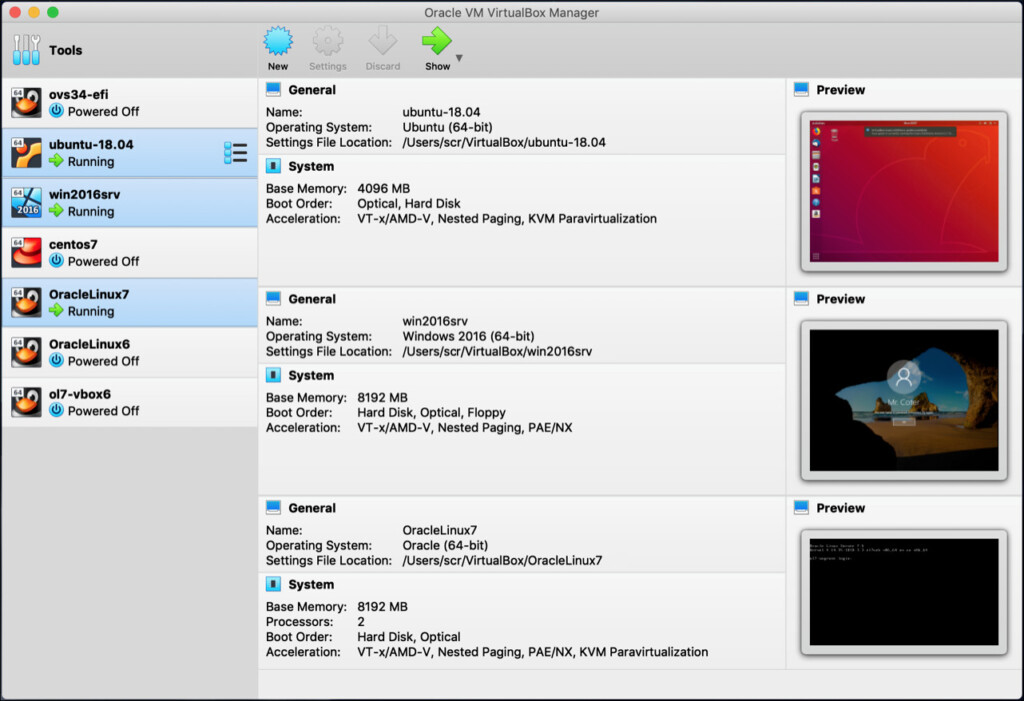
VirtualBox is a free open source virtualization software that supports a wide range of operating systems including Windows, Linux, Solaris and OpenBSD Unix.
VirtualBox even supports old versions of Windows such as 3.x although why you’d want to run such as old version of Windows apart from nostalgic reasons is another question.
Although VirtualBox is free and open source, its development is also supported by Oracle.
VirtualBox is certainly not recommended for beginners to virtual environments however.
Compared to Parallels, everything has to be setup and installed manually and the integration between macOS and Windows is nowhere near as good.
You can however run VirtualBox on Apple Silicon Macs to install Windows ARM, although running Windows in it is even more complicated than on Intel Macs.
You’ll need to do a lot of manual configuration to setup Windows on an Apple Silicon Mac using VirtualBox and it may also stop working when new updates to macOS are released.
Performance on Apple Silicon Macs can also be very unstable with some serious performance issues.
In fact due to difficulties with running VirtualBox on Apple Silicon, since version 7.0 VirtualBox has stopped developing a stable version for ARM based chips so currently you can only download an older test build for M1/M2/M3 chips.
Even worse, VirtualBox can’t install Windows on Apple Silicon Macs as it can’t run Windows ARM which is the only version of Windows that works on Apple Silicon Macs.
Since it’s an open source project with no official support team, it often takes a long time before VirtualBox is updated to work with new releases of macOS or updates to it.
The big plus of course is that VirtualBox is free, even for enterprise customers and if you only need occasional use of Windows on your Mac, it may be worth exploring.
Pricing: Free
Pros:
- Free to use
- Supports a wide range of operating systems
- Test builds works on Apple Silicon Macs
- Works well in Intel Macs
Cons:
- Difficult to setup and use Windows
- Only allows you to run Windows on Intel Macs, no support for M-chip Macs
- Serious performance issues on Apple Silicon Macs
- Integration between macOS and Windows limited
- Requires a lot of manual configuration
- No official support
- No stable version after 7.0 for M-series Macs
FAQs
What is a Virtual Machine?
VM’s, also known as virtualization machines, virtual environments or hypervisors, allow you to run another operating system in macOS.
Most commonly, virtual machines are used to run Windows on a Mac but they can also be used to run Linux and older versions of macOS too.
This might be to run a Windows only app that isn’t available for Macs or play Windows only games on a Mac.
Virtual machines are also popular with programmers and developers that need to test software in a certain operating system.
The main reason for this is that one of the major advantages of a virtual machine is that any viruses, bugs, or problems are isolated to the virtual machine itself due to the way they “sandbox” the operating system on your Mac.
So if your copy of Windows running in a virtual machine becomes corrupted or damaged in some way, you can simply reinstall it in the virtual machine with no effect on your Mac.
Virtual machines are one the easiest ways for most users to do all this because you can simply switch to Windows in macOS like you would with any other application on your Mac.
What are the advantages of using a Virtual Machine?
There are many advantages of installing a virtual machine on your Mac including some of the following:
- Saves money: You don’t have to buy an additional Windows laptop or PC just to use Windows applications. As long as you have plenty of storage on your Mac you can install a virtual machine on it or you can even install one on an external drive.
- Security: In the case of malware and viruses, most can’t even run properly in a virtual environment meaning its safer than using a Windows PC. If your Windows installation does get corrupted or infected, at the very worst you will simply have to reinstall Windows with no damage done to your Mac.
- Flexibility: Virtual machines give you freedom by providing a real installation of Windows that you can do pretty much anything you like with. This is compared to other methods such as accessing Windows in the Cloud which imposes far more restrictions on what you can do.
- Backwards Compatibility: Virtual machines can be used to run older or incompatible software on newer hardware, making it possible to maintain legacy systems and applications. So for example, if an app you were using on your Mac no longer works with the latest version of macOS, you can install an older version of macOS in a virtual machine and run it in there.
What are the disadvantages of using a Virtual Machine?
- Performance lag: Because they require a lot of RAM and processing power, VMs can run slow and even slow down your Mac although this is now less of a problem with the latest Apple Silicon M-series chip Macs.
- Anti-cheat software incompatibility: If you want to use a virtual machine to play PC only games, games that use anti-cheat software such as Vanguard and Denuvo won’t work in virtual environments.
- DirectX 12 incompatibility: Although they support DirectX 11, Virtual machines cannot run the latest DirectX 12 which is required by many games and applications. For this you need compatibility layers such as the Preview version of Crossover.
- Poor Frame Rates: While Virtual Machines allow you to run Windows only games, they often run at low frame rates – often less than 60 fps – because they can’t dedicate all of your Mac’s resources to running them.
- Steep learning curve: Although they’re generally easy to use, configuring a virtual machine to work optimally on your Mac can take time to get right. Some applications also require specific settings and tweaks to run well in them.
- Windows 11 ARM: Currently, virtual machines can only run Windows 11 ARM on Apple Silicon Macs. This is because the Intel version of Windows that most of us use only works with the Intel chip, not the Apple Silicon M-series chips. Although Windows ARM can run most apps thanks to something called “x86 emulation”, it doesn’t always perform well or even work with all apps. Microsoft doesn’t currently sell licenses for individual use of Windows ARM (only business licensing) but it does allow private individuals to use it for free.
What are the alternatives to virtual machines?
If you don’t need a full Windows desktop, there are other ways of running Windows on a Mac that can run Windows apps or even full Windows environments on a Mac with far less setup.
- Compatibility layers such as CrossOver, Whisky, and Wine translate Windows API calls into macOS equivalents, allowing many Windows applications to run without installing Windows at all. These tools are lightweight, fast to launch, and especially good for running specific apps or older games. However, compatibility depends on the application, and advanced features like drivers, complex installers, or modern DirectX graphics may not work reliably.
- Cloud-based solutions like Windows 365 via Windows App give you a full Windows PC streamed from the cloud. This avoids performance limitations on Apple Silicon and provides access to a genuine Windows environment, but requires a stable internet connection and, in the case of Windows 365, a monthly subscription.
These options can be excellent if you only need to run certain apps, want fewer system resources used, or don’t want to manage a full virtual machine. However, for the broadest app compatibility and best performance, a dedicated VM such as Parallels or VMware Fusion is still the most complete solution.
Why use a virtual environment?
The most common reason to use one is in order to use Windows only applications or games. Virtual machines are also popular with programmers and developers that need to test software in a certain operating system.
Although there are other ways of accessing Windows on a Mac, they don’t allow you the full freedom of doing whatever you want in the operating system.
What’s The Best Alternative To Parallels For Mac?
If you don’t want to pay for Parallels then VMware Fusion is easily the best alternative to it. Although it’s not as slick and polished as Parallels, it features similar one click installation of Windows and features.
Can I run Windows on an Apple Silicon Mac?
Yes, you can run Windows on an Apple Silicon Mac using virtualization tools like Parallels Desktop, VMware Fusion, and UTM. Currently, Apple Silicon Macs only support running Windows on ARM (WoA) although most Intel apps work with it thanks to x86 emulation in Windows.
Why can Apple Silicon Macs only run Windows ARM?
Apple Silicon Macs use M-series chips which are built on the ARM architecture. The standard version of Windows only runs on machines with Intel chips such as older Macs.
Windows ARM is very similar to the standard versions of Windows but some programs, apps and games won’t work natively in it.
Windows ARM can however “translate” most software to work with it thanks to something called x86 emulation although this doesn’t always work for all apps and sometimes results in slower performance.
Is it possible to run macOS in a virtual machine?
Yes, tools like Parallels Desktop, VMware Fusion Pro, and UTM support running macOS as a guest operating system, provided you comply with Apple’s licensing agreements.
What are the system requirements for running VMs on a Mac?
System requirements vary by software, but generally, you need a Mac with at least 8GB of RAM (16GB recommended for heavy use), sufficient disk space (at least 20GB free for the VM), and a modern multi-core processor.
How does virtualization impact Mac performance?
Running a virtual environment consumes resources (CPU, RAM, and disk space), which can impact macOS performance. Allocating too many resources to the VM can slow down your Mac. It’s essential to find a balance based on your Mac’s specifications and usage needs.
Can I transfer files between macOS and Windows with a VM?
Yes, most virtualization tools support shared folders or drag-and-drop functionality, allowing you to transfer files between macOS and the virtual machine easily.
Are there any free virtual machine solutions for Mac?
Yes, since November 2024, VMware Fusion Pro is free for personal, educational and even commercial use.
VirtualBox and UTM are free, open-source options that offer robust virtualization capabilities.
UTM is tailored for Apple Silicon Macs and even allows you to emulate x86 Intel versions of Windows too.
Which VM is best for gaming on a Mac?
Parallels Desktop and VMware Fusion Pro are the best options for gaming on a Mac due to their high performance and excellent graphics support. However, performance may still not match that of native Windows PCs.
For more on this check out our guide on the best way to play Windows games on a Mac.
Can I use external hardware with these on a Mac?
Yes, you can use external hardware such as USB devices, SSD drives, Thunderbolt drives, printers, and even GPUs (with compatible software) with your virtual machines. Most virtualization software support peripheral device integration but we found that Parallels makes this easier than any other VM.


